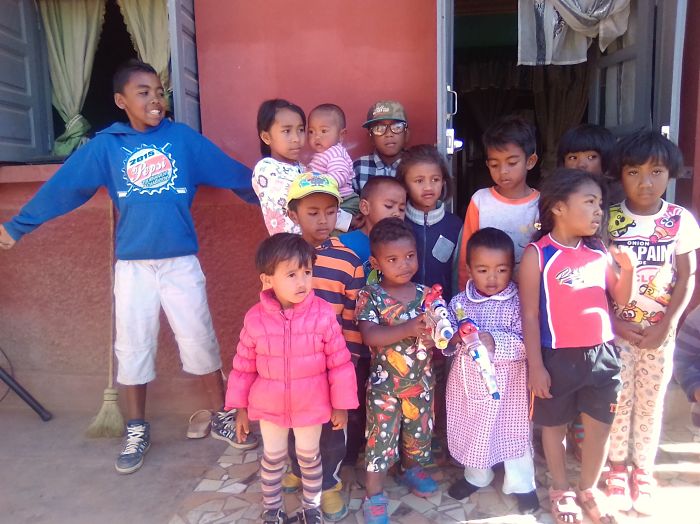
The Malagasy circumcision celebration
Loud music, people dancing and drinking, a little boy surrounded by a mountain of toys… It’s the Didimpoitra celebration! Men proudly carrying their sons dressed in red, festivities lasting for weeks: this is Sambatra! Circumcision takes different forms across the island, but its symbolism remains the same!
In Madagascar, all boys must go through this tradition to be truly considered as men (belonging to the male gender). In certain ethnic groups on the island, uncircumcised men cannot be buried in the family tomb (fasan-drazana). Circumcision remains a deeply rooted tradition in Malagasy society, although it is increasingly adapting to modern times.
The course of the didimpoitra
In Imerina, in the Highlands region, circumcision (didimpoitra, famorana, or hasoavana in Malagasy) is performed on boys around 3 years old. It always takes place during the Malagasy winter, between May and August, as the cold helps wounds heal more quickly. Traditionally, the procedure could not occur without the approval and guidance of a mpanandro (a sort of seer-shaman), as the date must be chosen according to the boy's andro nahavelomana (day of birth).
Traditional rites remain strong in rural areas, while in larger cities, the process is simplified to better accommodate both the boy and his parents. It is a fascinating tradition to discover during a trip to Madagascar.
Circumcision in the countryside (as practiced for centuries)
The hasoavana is a major celebration attended by the entire family. It takes place in a dedicated house or room prepared for the occasion. Festivities begin on the eve of the main day, involving dancing and singing that last until the end of the event. Traditional instruments such as the valiha, flute, and drums are central to the music! Men drink alcohol in abundance, as in all Malagasy celebrations. Nobody sleeps, as the night holds great significance !
At around 2 or 3 a.m., the strongest men (whose parents are still alive) set out to fetch rano mahery at the foot of a mountain—a kind of sacred water used to wash the circumciser's hands, the knife, and the child's wound. Upon their return, those waiting in the house attempt to spill the rano mahery gourd to prevent it from reaching the circumciser. If it is spilled, they must go back to the source! Once it finally passes through, the water is said to be truly powerful (rano mahery). These men also bring sugarcane to symbolize a less difficult life for the boy and a banana tree to ensure fertility and many children in the future.
At around 4 or 5 a.m., the rain-jaza (circumciser) begins the operation after the mpanandro or the eldest of the gathering prays for a smooth process. Meanwhile, the mother, sisters, aunts, and cousins remain cloistered in a room, also praying aloud to avoid hearing any potential cries from the boy. The men present make noise by banging on anything they can find to drown out any sounds, ensuring the women don’t hear.
It is worth noting that the rain-jaza is a special individual with a unique gift, similar to the mpanandro. He possesses a talent for healing wounds and stopping bleeding. For his gift to remain effective, he must observe certain fady (taboos), as must the entire gathering. Generally, no one is allowed to have sexual relations on the night of the circumcision.
Once the foreskin (lohatsitsy in Malagasy) is removed, the assembly shouts “‘zay no vita e!” (It’s done!), and the maternal grandfather eats the piece of skin with a banana, symbolizing fertility and virility.

The child is pampered with gifts and quickly falls asleep. Everyone celebrates, especially after offering the tsodrano (blessing), often in monetary form, as is customary. A kabary (speech) of thanks closes the event.
Circumcision in the city (adapted to modern times)
For city dwellers, any winter day is suitable for the didimpoitra. A medical doctor performs the circumcision in their office or operating room. The celebration begins the night before or not at all, depending on the family’s means and preferences. In the morning, male family members take the young boy to the practitioner. Their role is to hold his arms and legs to prevent movement. The uncle or maternal grandfather swallows the foreskin with a banana. The child is then returned to his mother, who is often anxious until full healing occurs.
The return home is joyous! Everyone shouts “arahaba ririnina e!” (Congratulations in this wintertime), as is the custom. The boy is showered with toys to distract him from the pain and make this special occasion memorable, marking his passage into manhood. Sometimes, he even cries while playing! The celebration is lively, filled with food, alcoholic and non-alcoholic drinks, singing, and dancing.
The evolution of circumcision
Today, parents with the means often opt for modern medicine to ensure their child’s safety. The American-style circumcision is increasingly popular! Some medical centers use a mild anesthetic gas to ease the boy’s pain.